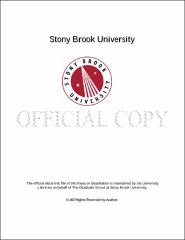| dc.identifier.uri | http://hdl.handle.net/11401/78337 | |
| dc.description.sponsorship | This work is sponsored by the Stony Brook University Graduate School in compliance with the requirements for completion of degree | en_US |
| dc.format | Monograph | |
| dc.format.medium | Electronic Resource | en_US |
| dc.format.mimetype | Application/PDF | en_US |
| dc.language.iso | en_US | |
| dc.type | Thesis | |
| dcterms.abstract | Fresh water scarcity is an urgent challenge in many regions around the world, where desalination of brackish water and seawater has become one of the most promising solutions. In desalination, the reverse osmosis (RO) membrane technology, developed in 1960s, is the most state-of-the art solution. However, the relatively low filtration efficiency of RO membranes is still the major hurdle that limits the overall performance of desalination. Currently, interfacial polymerization is a common approach to fabricate RO membranes, in which two reactive monomers: such as m-phenyldiamine (MPD) and Tirmesoyl chloride (TMC), dissolved in two immiscible phases (i.e., aqueous and organic phases, respectively), can react at the interface to form a thin polyamide barrier layer. To overcome the low filtration efficiency (low flux), it is important to learn the formation mechanism of polyamide layer and the resulting structure. For this purpose, we first investigated the freestanding polyamide layer without the scaffold support. In specific, grazing-incidence wide-angle X-ray scattering (GIWAXS) was used to inspect the inter-molecular structure of free-standing polyamide layer, with the layer thickness was controlled at around 3 nm, where reflectometer was used to determine the film thickness and surface smoothness. The results revealed the relationships between the barrier layer thickness, monomer concentrations, monomer types during interfacial polymerization. Finally, the RO membrane based on the same polyamide barrier layer was tested by a high-pressure desalination system at 800 psi, to correlate the polyamide structure with desalination performance. | |
| dcterms.available | 2018-07-09T13:37:08Z | |
| dcterms.contributor | Hsiao, Benjamin S. | en_US |
| dcterms.contributor | Dill, Ken A. | en_US |
| dcterms.contributor | Takeuchi, Esther S. | en_US |
| dcterms.creator | Fu, Qinyi | |
| dcterms.dateAccepted | 2018-07-09T13:37:08Z | |
| dcterms.dateSubmitted | 2018-07-09T13:37:08Z | |
| dcterms.description | Department of Chemistry. | en_US |
| dcterms.extent | 45 pg. | en_US |
| dcterms.format | Monograph | |
| dcterms.identifier | http://hdl.handle.net/11401/78337 | |
| dcterms.identifier | Fu_grad.sunysb_0771M_13457.pdf | en_US |
| dcterms.issued | 2017-08-01 | |
| dcterms.language | en_US | |
| dcterms.provenance | Submitted by Jason Torre (fjason.torre@stonybrook.edu) on 2018-07-09T13:37:08Z
No. of bitstreams: 1
Fu_grad.sunysb_0771M_13457.pdf: 2085452 bytes, checksum: cd1728e7086d9bd23131f93f3b00687c (MD5) | en |
| dcterms.provenance | Made available in DSpace on 2018-07-09T13:37:08Z (GMT). No. of bitstreams: 1
Fu_grad.sunysb_0771M_13457.pdf: 2085452 bytes, checksum: cd1728e7086d9bd23131f93f3b00687c (MD5)
Previous issue date: 2017-08-01 | en |
| dcterms.subject | Desalination | |
| dcterms.subject | Chemistry | |
| dcterms.subject | GIWAXS | |
| dcterms.subject | Polyamide Barrier Layer | |
| dcterms.subject | Reflectometry | |
| dcterms.subject | Reverse Osmosis | |
| dcterms.title | Study of Polyamide Barrier Layers in Reverse Osmosis Membranes | |
| dcterms.type | Thesis | |

